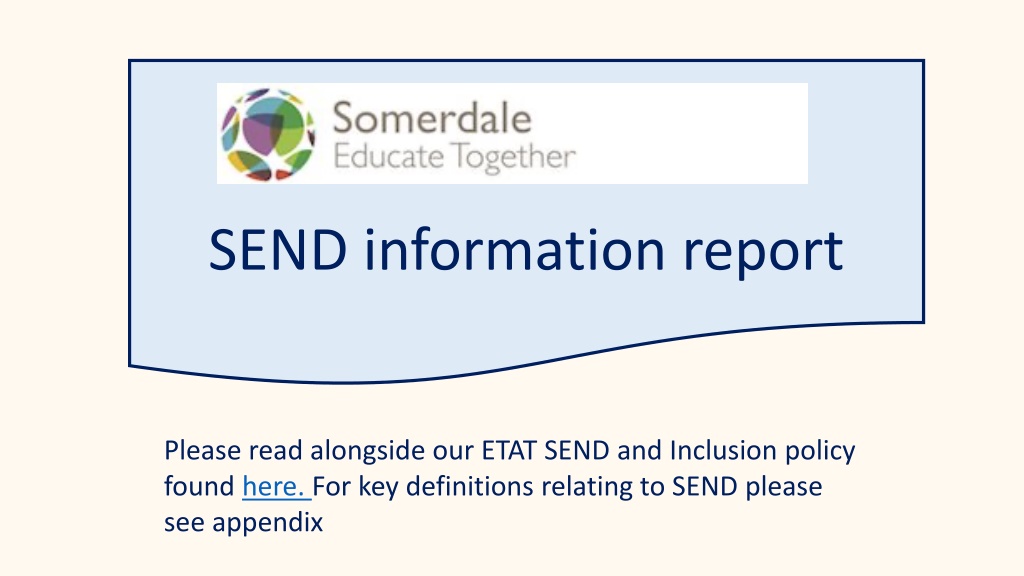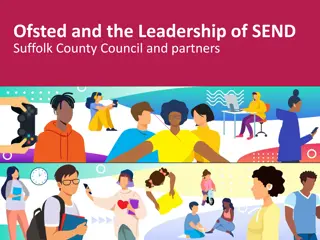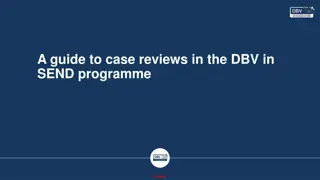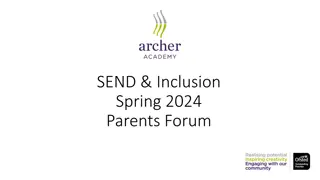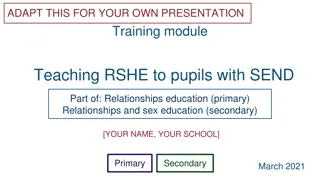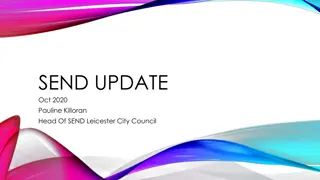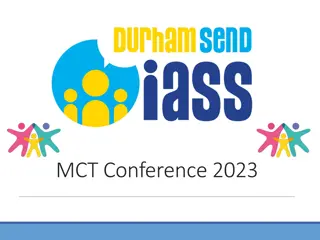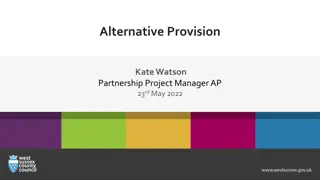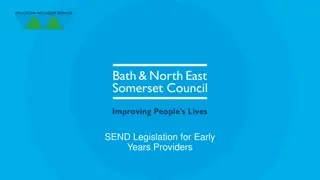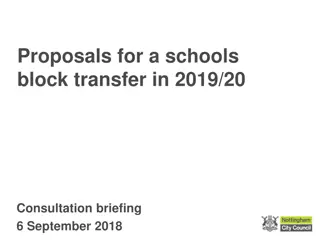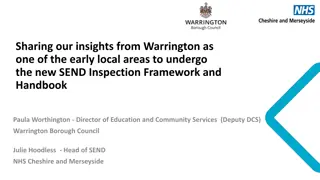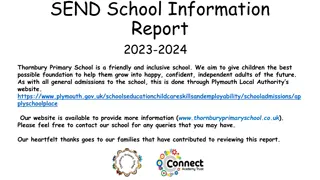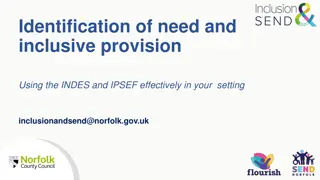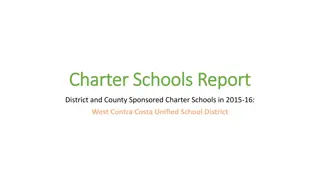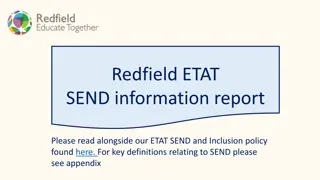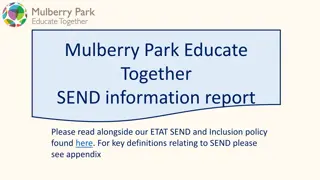SEND Provision Report at Somerdale School
Somerdale School provides additional and/or different provisions for approximately 14% of pupils with a range of Special Educational Needs and Disabilities (SEND) including Dyslexia, Autism Spectrum Condition (ASC), Vision Impairment, and ADHD. The school maintains an SEND register categorizing pupils based on their needs, ensuring appropriate support and monitoring. Parents are actively involved in the process and notified accordingly.
Download Presentation

Please find below an Image/Link to download the presentation.
The content on the website is provided AS IS for your information and personal use only. It may not be sold, licensed, or shared on other websites without obtaining consent from the author.If you encounter any issues during the download, it is possible that the publisher has removed the file from their server.
You are allowed to download the files provided on this website for personal or commercial use, subject to the condition that they are used lawfully. All files are the property of their respective owners.
The content on the website is provided AS IS for your information and personal use only. It may not be sold, licensed, or shared on other websites without obtaining consent from the author.
E N D
Presentation Transcript
SEND information report Please read alongside our ETAT SEND and Inclusion policy found here. For key definitions relating to SEND please see appendix
Contents page 1. What type of SEND do you provide for? Slide 3 5. Access to specialist support from external professionals and organisations Slide 29 2. How do you identify and assess the needs of pupils with SEN? Slide 6 6. How do you support Looked after children who also have Special Educational Needs? Slide 31 3. Who should I contact if I want to share information about an existing SEND need or I think my child has SEN? Slide 12 7. How will you support my child when they start/leave your school or move to another year group? Slide 33 4. What is your approach to meeting the needs of children with SEND Slide 14 8. How do you evaluate the effectiveness of the provision made for pupils with SEND? Slide 35 4a. How do you use assessment Slide 16 9. How do you ensure Inclusion in all activities? Slide 37 4b What is your approach to planning and reviewing Slide 18 10. How do you ensure the emotional and social development of pupils with SEND? Slide 39 4c. How do you adapt the curriculum for pupils with SEND Slide 21 11. What do I do if I want to make a complaint about SEND provision at your school? Slide 43 4d. How do you ensure Quality First Teaching and an Inclusive learning environment Slide 23 12. How can I find out more about the local offer? Slide 45 4e. What additional support is available for pupils with SEND? Slide 26 13. Contact details of support services for parents of pupils with SEND Slide 47 4f. Skillset and training of staff Slide 27 Key definitions Slide 49
1. What type of SEND do you provide for? Click here to go back to contents page
Our school at Somerdale currently provides additional and/or different provision for approximately 14% of our pupils. These pupils have a range of SEND need across the four categories below and including Dyslexia, ASC, Vision impairment and ADHD. Cognition and Learning needs (16%) This category of need includes: Dyslexia Dyscalculia Processing difficulties Memory Communication and Interaction needs (39%) This category of need includes: Understanding language (receptive) Using language (expressive) Speech Autism Spectrum Condition Physical and Sensory needs (13%) This category of need includes amongst others: Visual impairments Hearing impairments Fine and Gross motor skills/mobility Sensory processing difficulties Social, Emotional, Mental Health needs (32%) This category of need includes amongst others: Social understanding and interaction ASC
We keep a record of all pupils who require additional and/or different provision using our SEND register. We use four different categories when recording pupils on the register. SEND support (official SEND register) Term used nationally (SEND code of practice) Descriptor given for pupils who are identified as SEND but whose needs can be met by targeted provision using resources from school budget Parents/carers always notified of status EHCP (official SEND register) Term used nationally (SEND code of practice) Descriptor given for pupils who are identified as SEND but whose needs cannot be met using the school's internal SEND budget (element 2 funding) and who require further specialist support and provision. Parents/carers always notified of status Monitoring Term created for internal use at Educate Together Pupils on Inclusion register but not counted as official SEND register Used when a child has come off the SEND register. We carry on monitoring for another 12 months before completely removing a child Investigating Term created for internal use at Educate Together Pupils on Inclusion register but not counted as official SEND register Used during step 3a of "Identification and Assessment procedures" (see slide 12)
2. How do you identify and assess the needs of pupils with SEN? Click here to go back to contents page
Progress as an indication of SEN The SEND code of practice (2015) states that a potential need for Special Educational Provision is identified when a pupil s level of progress: Is significantly slower than that of their peers starting from the same baseline Fails to match or better the child s previous rate of progress Fails to close the attainment gap between the child and their peers Widens the attainment gap This may include progress in areas other than attainment, for example, social needs, difficulties with emotional regulation or physical development.
Our Identification and Assessment Procedures for SEN High Quality Teaching as foundation To identify Special Educational Needs, the highest priority and first consideration must be to ensure that all pupils receive high quality teaching which uses inclusive practices to remove barriers to learning. With this foundation, a consistent use of the graduated approach to SEND support is then used to identify pupils with Special Educational Needs.
Our Identification and assessment procedures for SEN Step one: assessment at whole school level: Regular assessments for ALL pupils as part of school assessment cycle Whole school tracking data Early identification of any specific barriers to learning through whole school screeners: Language for Life (Pre-school and Reception) and GL Ready Rapid Dyslexia screening (Year 3, after child has turned 8) Step two: Plan and carry out intervention (do) Pupils whose progress is a cause for concern are discussed at termly progress meetings.* Class teacher uses assessment information to identify any specific areas of weakness and implement a targeted intervention plan to be reviewed alongside SENCo within one term. The class teacher can do this at any point during the year if they identify concerns before termly progress meetings. A targeted intervention plan can also be triggered if a parent raises a concern about a child at any point during the year. * Pupils who have made accelerated progress are also discussed and, if appropriate, pupils may be moved from SEND support to monitoring on the SEND register.
Step three: review 3a) Pupil fails to make expected progress despite high quality teaching targeted at their areas of weakness The class teacher and the SENCo in collaboration with the child/parents use the SEN toolkits to assess whether the child has a learning difficulty or disability which calls for special educational provision to be made for them Other potential causes for lack of progress are explored e.g. pastoral concerns, EAL. If a Special Educational Need is identified, the child is added to the SEND Register as SEND support . A decision may also be made to place the child as Investigating if further investigation is required. 3b) Pupils makes expected progress - If the progress appears to be dependent on support that is additional to and/or different from the mainstream offer see step 3a) - If all gaps in learning have now been closed, no further action is required.
Step four: Successive cycles of the graduated approach (SEND support) Planning and review meeting held by SENCo and class teacher with pupil, parents and other key professionals in order to: - Carry out a clear analysis of need and agree sought outcomes - Create a One Page Profile and provision map and, when there are specific targets to work towards*, an individual learning support plan to include identified strengths and target skills, next steps and agreed provision. The type of plan will vary depending on the type of need. Provision continues to be reviewed and adapted on a termly basis using successive cycles of the graduated approach. This may include input from external professionals and specialist advice or assessments if strategies put in place by the school are not sufficient in meeting the child s needs. If the child requires support that extends beyond what can be provided using element 2 funding, a request for an Education Health Care Plan assessment should be considered in collaboration with the pupil and parents/carers. You can find more details about EHCP assessments here. If granted, the child is recorded on the SEND register as EHCP. *In some cases, when the focus is on adaptations the school needs to make to the environment, a One Page Profile and provision map is sufficient Click here for a one-page summary of our identification and assessment procedures for SEN
3. Who should I contact if I want to share information about an existing SEND need or I think my child has SEN? Click here to go back to contents page
3. Director of Inclusion 1. Class teacher 2. SENCo Please contact your child s class teacher first. They will discuss your concerns with you and agree on next steps to ensure your child receives the support they need. The SENDCo is Becky Ware. Her working days are Tuesday, Wednesday and Friday. See page 108 of the SEND code of practice (click here) for a full description of the SENCo role. If you have any queries related to SEND provision you are invited to contact Becky at any point during the school year: senco@somerdaleet.org.uk Our Director of Inclusion Laura Bazell works alongside SENCos in each school to provide additional support and guidance and may participate in meetings to discuss the needs of your child. Click here to find out more about Laura. directorofinclusion@educatetoge ther.org.uk When appropriate, they will liaise with you, your child and the school SENCo to implement the graduated approach to SEND support as outlined in this report
4. What is your approach to meeting the needs of children with SEND? Click here to go back to contents page
Successive cycles of the graduated approach For children identified as having SEND, we continue to use the graduated approach to gain a greater understanding of the child's needs and what supports them to make progress, secure positive outcomes and feel happy and safe at school. We complete one cycle each long term (x3 per year) and key information is recorded using the documents described on this page. See following slides for more details One Page Profiles (OPPs) We work with all of the children on the SEND register, alongside their parents/carers and key staff members to create a One Page Profile. These profiles are available in the classroom to ensure easy access for all adults. For pupils who do not require individualised targets an OPP is all that is required. Other pupils also have the documents described below Pupil/parent voice must have central role Graduated approach assess, plan, do, review Individual provision maps For pupils at SEND support (see slide 8) a provision map is included on the back page of their OPP to identify which elements of our core offer (slide 24) are of particular benefit. Any additional provision is recorded on their ILP. Pupils with EHCPs have a one- page summary of the provision outlined in their EHCP on the back of their OPP. Individual learning plans (ILPs) SEND support For pupils requiring individual targets, we have individual learning plans. They are used as a record of termly assessment, planning, additional provision and reviews. These plans are updated each long term (x3 per year) with parents, pupils, the class teacher and, when relevant, the SENCO and external professionals. The type of plan varies from child to child depending on their specific areas for development or support. EHCP Each long term (x 3 per year), there is a learning plan meeting with parents, teachers, SENCO, pupil (when appropriate) and external professionals (when possible) to identify the next steps for each child in working towards their overall outcomes from section E of their EHCP. Pupil voice: Whenever possible, pupils play a central role in setting their own targets and choosing how they will monitor their progress in order to encourage full ownership.
Graduated approach to meeting needs of children with SEND (Assess) 4a. How do you use assessment to meet the needs of children with SEND? Click here to go back to contents page
What small steps assessment tools do you use? Use of small step assessment tools In addition to our whole school assessment approach (see slide 8), when useful, we may use further small step assessment tools for children with SEND. The main tools we are currently using are: Maths: Sandwell numeracy Reading: Benchmarking Sight words: Common exception words assessment Spelling: Common exception words assessment Phonics: End of Y1 phonics screener SEMH: THRIVE Speech and Language: Infant language link Click on titles above for more details What s the process? We carry out these assessments 3 times a year, just before we have SEND progress (ILP) meetings. Results are recording on Individual learning plans and used to help everyone at the meeting review progress and agree on next steps. Why? Use of these tools can help show small steps progress and build self-esteem Progress measures enable us to gain a further understanding of a child s needs and whether the provision we have in place is working. For more specific needs, we use individually tailored assessments which may include tools given by external professionals.
Graduated approach to meeting needs of children with SEND (Plan and Review) 4b. What is your approach to planning and reviewing to meet the needs of children with SEND? Click here to go back to contents page
Setting termly SMART targets Section E of the EHCP details the overall outcomes that have been agreed for the child. During the annual review, we aim to agree on short term targets for the next year. At each termly progress meeting, we review progress towards the yearly short- term targets and support the pupils and their parents/carers to choose next steps for the following term based on progress made so far and advice from external professionals and the class team. EHCP progress meetings and annual review x 3 meetings per year For pupils with EHCPs, we have three meetings each year with the pupil (if able to access the meeting), parents or carers, the class teacher and the SENCO two progress meetings and one annual review. External professionals are given the dates for these meetings at the start of the year and attend when possible, prioritizing the annual review. The SEND officer from BANES LA is also invited to the annual review but is not always able to attend. For more details on the Annual review process see SEND page. Termly planning and reviewing for pupils with EHCPs Planning for provision We review provision from section F of the EHCP each term. If any of the agreed provision is not working, we agree on new strategies or approaches to try. Any changes made during the year are added as annotations to section F during the annual review process Steps to Success mentoring (for pupils who are able to access this approach) SMART targets are written in a way which helps to track progress. However, the language used in SMART targets is not always child friendly. When appropriate, we encourage pupils to put targets into their own words and think about how they can achieve the targets and what tools they can put in place within the classroom to help them remember and track their progress. This process supports a skill called Meta-cognition one of the most effective strategies for supporting learning according to the Education Endowment Foundation s study of the impact of different types of interventions.
Individual learning plans (SEND progress meetings) x 3 per year We have SEND progress meetings three times a year with the pupil (if able to access the meeting), parents or carers and the class teacher. When relevant, the SENCO and/or external professional are also present. We use this meeting to review progress and create an updated individual learning plan for the next term. Team approach to setting targets We encourage pupils and their parents/carers to choose next steps based on: their own aspirations and interests their strengths assessment and review information that we share Suggested next steps from external professionals (if relevant) Advice from class teachers Planning for provision When setting targets, we also agree how the child will be supported to meet those targets. Provision from the core offer will be recorded on the child s OPP and provision map. Any provision that is different from or additional to the core offer will be noted on the child s ILP. During the meeting we also review provision already in place and whether it is working or not. Termly planning and reviewing for pupils at SEND support Pupil ownership of targets and metacognition. When setting targets as a team (some targets are given e.g. targets from a Speech and Language Therapist), we aim to maximise the role of the pupil and their parents or carers. We use a specific set of questions to enable pupils and their parents to clarity the exact goal and decide how it will be measured, how progress will be monitored, what support will be in place and what everyone s roles will be. The use of these questions supports a skill called Meta-cognition one of the most effective strategies for supporting learning according to the Education Endowment Foundation s study of the impact of different types of interventions.
Graduated approach to meeting needs of children with SEND (Plan) 4c. How do you adapt the curriculum for pupils with SEND? Click here to go back to contents page
Adapting our Curriculum for pupils with SEND Our aim is to provide a high quality, equality-based education which is inclusive of all children. We aim to ensure that: all children have equal opportunities to access the curriculum all children contribute and participate in all aspects of school life alongside their peers all children have the support and provisions necessary to enable them to learn and achieve Our school offers a broad, balanced and ethical curriculum. We adapt the curriculum for pupils with SEND in the following ways: High Quality Teaching, accessing a broad and balanced curriculum where barriers to inclusion are removed. Using a range of different teaching and learning strategies. Using resources or equipment to support a specific need. Using scaffolding to provide support. Differentiated learning materials. Providing in and/or out of class support. Using flexible groupings. Providing specific interventions or boosters in small groups or 1:1. Implementing support and advice from external agencies. Providing a broad range of extra-curricular activities. Our curriculum includes not only the formal requirements of the National Curriculum, but also our ethical education curriculum. This program is called the Learn Together curriculum and is published by Educate Together. It defines the core values of all teaching and learning in the school. It is subject to continuous review and development. Our curriculum also includes the social aspects that are essential for developing independence and personal development for all pupils.
Graduated approach to meeting needs of children with SEND (Do) 4d. How do you ensure High Quality Teaching and an Inclusive learning environment? (First step and foundation for quality SEND support - core offer) Click here to go back to contents page
Communication We aim to create communication friendly classrooms by: Using simple, literal language (avoiding double- meanings) Providing step by step instructions (oral and or written) with visual support, if necessary, e.g. use of visuals to accompany key words or use of different coloured pens to highlight key words Wearing lanyards with key visual prompts to support communication needs of the class e.g. emotions cards or prompts for expected behaviours Repeating instructions and checking for understanding, as required. Offering choices Pre-teaching new and important concepts including relevant vocabulary - Word Aware approach Clarifying, explaining and checking understanding of vocabulary as we teach Supporting pupil expression through the use of sentence starters/language stems and other visual scaffolding e.g. Colourful Semantics Allowing extra time for processing e.g. ask question and then come back/use of reflection time Use of Talk partners Teaching and learning strategies Use of formative and summative assessment to inform planning for class and individual differentiation Learning which is differentiated, cumulative and multi-sensory with opportunities for repetition and over-learning Marking/ feedback/monitoring which identifies individual next steps and is responsive to any individual targets/plans Feedback which encourages a growth mindset and praise for effort as well as accuracy Use of targeted and differentiated questioning that provides challenge and encourages metacognition Allowing understanding to be demonstrated in different ways (oral reports, video presentations, posters etc) Opportunities for whole class learning breaks / movement breaks / sensory breaks within each learning session Environment and resources Use of visuals Large visual timetable at front of class Visual prompts for rules and behaviour Labelling of resources Visual schedules for key routines Visual task break downs What a good one looks like Understanding and identifying emotions display linked to Zones of regulation curriculum. IWB formatting to follow guidelines from British Dyslexia Assoc Resources to support subject based learning Reading rulers/bookmarks Pencil grips, variety of pens/pencils to try Word mats /lists/ vocabulary cards Letter and number strips for students to look at to see how to write them correctly Writing frames, Sentence starters, Individual whiteboards for drafting, colourful semantics resources Number lines/Numicon/counters/cubes etc Concrete resources/props/stimuli Handouts available using British Dyslexia Association guidelines Other General social stories for whole class use Sensory box with sensory toys and resources to access as needed - with support/direction. Cosy/quiet corner to access as needed for calm time or time outs Educate Together High Quality Teaching (Core offer we aspire to) The class community Classroom charter created and agreed by pupils using Rights Respecting approach Clearly displayed classroom rules and consistent use of rewards and consequences Whole class Zones of Regulation curriculum to develop an understanding of our emotions and our states of alertness and how to manage them. Opportunities for pupils to have individual roles and responsibilities within the class Topics which engage and reflect the lives, cultures and experiences of all our learners Additional support from others Extra adult support for differentiated targets and use of key resources or strategies Learning buddies Play buddies Seating arrangements including proximity to teachers/a buddy/ avoidance of distractions or sensory overload Catch up groups/boosters for Maths, reading, phonics, spelling, writing
Graduated approach to meeting needs of children with SEND (Do) 4e. What additional support is available for pupils with SEND (additional to and different from offer, including EHCPs) Click here to go back to contents page
Educate Together Provision that is different from or additional to the core offer (SEND support) Cognition and Learning needs Additional resources Coloured overlays Light blue or beige/cream writing paper Individual, visual task break downs or schedules Interventions Precision Teaching (core skills) Phonics Reading Reading/Spelling-NESSY TEACCH multi-sensory, structured approach to learning Referral to an Educational Psychologist or a Specialist Teacher and programme of support Social, Emotional and Mental Health needs Additional resources Now/next board Individual visual timetables Visual schedules for key routines Five-point scale or similar Reward chart Calm box Choosing board Individual behaviour plan Reward chart Personalised Social Stories Zones of Regulation Stations within each classroom Interventions Thrive sessions Zones of regulation sessions Play skills/social skills Referral to SaLT /EP/Behaviour support and programme Communication and Interaction needs Additional resources Key individualised visuals to support communication PECS Makaton Specialist assistive technology including ICT resources. Interventions Attention Autism Lego Therapy Colourful Semantics Speech and Language Therapy (SaLT) referral and programme of support including specialist areas e.g. speech, voice, support for selective mutism Physical and Sensory needs Additional resources Desk slope/pencil grips Sensory toys, manipulatives, resources Ear defenders Handouts with extra large print. Bands for chair legs Interventions Sensory regulation exercises Use of sensory room Fine motor skills Handwriting Physiotherapist or OT referral and programme of support Education and Health Care plans (EHCPS): We use our Element 2 budget to provide additional support described above. If a pupil requires highly specialized support that goes beyond the school s resources, the school may request an assessment for an EHCP and additional funding to ensure the right level of support. Click here for more information on EHCPS
Graduated approach to meeting needs of children with SEND (Do) 4f. What is the skillset of your staff and what training have they received in relation to supporting children with SEND? Click here to go back to contents page
Skill set and professional development for staff in relation to SEND Whole school training past 2020-2023 Individual Staff CPD SEND TEAM At ETAT, we are in the process of developing a SEND learning pathway with essential modules for all staff members to complete. The training covers knowledge of different types of SEND, implementation of the graduated approach to SEND support and all the strategies and interventions that form both our core offer and our different from and additional to offer. When appropriate, targets for SEND are included within yearly performance development reviews Staff specialisms and learning support structure Within our Learning support team, different staff members take the lead for specific areas of support. Ensuring a wide range of skills, training and knowledge informs recruitment decision. The learning pathway gives option for staff to further develop areas of expertise in specific areas. Becky (our SENCO) has held the National Award for Special Educational Needs Coordination since 2017. Becky has been a qualified primary school teacher for 10 years and enjoys her career very much. - - - - Graduated approach to SEND support SMART target setting Use of small steps assessment tools Benchmarking for reading Sandwell numeracy Common exception word assessments GL ready Dyslexia screeners Autism Awareness Zones of regulation strategies to support sensory and emotional regulation De-escalation strategies Restorative Justice Emotions coaching Colourful semantics (language structure) Lego Therapy In addition, SENCOs across the trust receive support and guidance, including termly training sessions with our Director of Inclusion, Laura Bazell. Click here for more information about Laura External professionals Our team of external professionals (see slide 29) offer coaching and training on specialist strategies and interventions required for pupils on an individual basis. This is another way in which staff are able to develop areas of expertise.
5. How do you ensure that children have access to specialist support from external professionals and organisations? Click here to go back to contents page
The school works in partnership with a range of specialists commissioned through the Local Authority, and other providers, including: Local authority education and health care providers BaNES SEN team. Our link Inclusion officer is Ben Gulvin. The speech and Language team. Our link therapist is Gemma Elliott. Child and Adolescent Mental Health Service (CAMHs). Primary Mental Health Specialist Educational Psychologists (EPs) Occupational Therapists (OTs) Community paediatrics Specialist Autism Support Service (SASS) . Sensory Support Service (for visual and hearing impairments) School Nurse service Families in Focus Private organisations and charities Local community Our collaborative principle Brighter Futures Educational Psychology services we have contracted a minimum of 15 days per year across the Trust for additional advice, supervision and assessment work. As part of our collaborative principle, we are seeking to increase our collaboration with parent and local community volunteers this year so that we can extend the range of interventions we run for children in school and expand our knowledge and skills base by receiving input from local specialists. Please do get in touch if you are interested in volunteering, or you have specialist skills or knowledge you would like to share in relation to supporting our children with SEND.
6. How do your support Looked after Children (LAC) who also have Special Educational Needs? Click here to go back to contents page
Supporting Looked after children who are also on the SEND register Personal Education Plans The graduated approach is recorded using a Personal Education Plan (PEP) This is similar to an individual learning plan. Graduated approach As with all our pupils on the SEND register, we use the Graduated approach to ensure quality SEND support. Termly multi-professional meetings The pupil (when appropriate), class teacher and carers will meet three times a year (as with all SEND pupils) to update the PEP and review support. An advocate from the Hope Virtual School and the Designated Teacher for Looked after Children (currently Chris Thomas-Unsworth) also attends the meeting. Collaborative approach between SENCO and the Designated teacher The Designated teacher for Looked after Children and the SENCO work together to ensure the school is working collaboratively to ensure the best support possible.
7. How will you support my child when they start/leave your school or move to another year group? Click here to go back to contents page
Supporting children with key transitions Individualised transition programmes We create transition programmes based on the child s needs and the type of transition. Examples of support could include: Regular conversations with staff members about the new setting. Use of key visuals e.g. countdown timetable, transition booklet with key information and pictures of the new setting Individual and/or whole class transition visits to the new setting Providing opportunities for staff from the new setting (when appropriate) to visit and spend time with the pupil at our setting. If required, we can look at visits both during and after the school day. When needed, we will work with parents or carers to arrange an initial transition timetable moving from part-time attendance to full time. Understanding that transitions require support We know know that change can be particularly challenging for many children with SEND. We implement individualized transition programmes to ensure the process is as smooth as possible. Collaboration If your child is going to or coming from another setting, we work closely with that setting to ensure we have shared all the key information required for your child to continue receiving the support they need. Teachers hold handover meetings and work closely together to ensure effective transitions from one class to another.
8. How do you evaluate the effectiveness of the provision made for pupils with SEND? Click here to go back to contents page
Evaluating the effectiveness of SEND provision Termly individual reviews (Graduated approach) The termly reviews as part of our SEND progress meetings (see slide 28) enable us to monitor and evaluate the effectiveness of SEND provision for each individual child. Governor visits Our SEND governor is Lesley Jones. We have a governor visit three times a year. These visits enable us to further evaluate the effectiveness of our SEND provision Parental surveys We send out SEND surveys once a year to get feedback on our SEND provision, identifying what is working well and ways in which we can improve. Use of data We evaluate progress data for individual children (recording in individual learning plans) and also for the cohort of pupils within our school who have SEND. This gives us an overview of the impact of our SEND provision and how effective it is. We use this information to make adjustments and adapt our approach to ensure continuous improvement
9. How do you ensure that pupils with SEN are fully included in all aspects of school life? Click here to go back to contents page
Ensuring Inclusion for all Removing barriers We always consider opportunities and experiences that are inclusive and accessible to all. Should any child need specific support to access these activities, the school will endeavour to provide the necessary resources/training to achieve inclusivity Wide range of opportunities for all Our school offers a wide and enriched curriculum with afterschool clubs, educational day trips/experiences and residential trips, all providing a range of opportunity and experience for all pupils. Planning ahead All school trips are fully risk assessed and we provide the appropriate support for children with SEND to attend all trips. For example, this may include additional adult support on the trip or the use of social stories in advance of the trip. Extended provision We also offer extended provision for pupils through our Breakfast club and Afterschool Club which is available to all children. Provision for any child with additional SEND will be supported.
10. How do you ensure the emotional and social development of pupils with SEND? Click here to go back to contents page
Ensuring the emotional and social development of pupils with SEND Whole school curriculum and ethos Whole school ethos and values The school has a strong set of values based on our four principles of education that is: Equity based Aspirational Child-Centred Collaborative These principles support the emotional and social development of all our pupils and underpin the policy and practice of the whole school. Learn Together Curriculum Through our unique Learn Together curriculum, all children learn how to show respect to others and are encouraged to make positive choices and learn together, building a strong ethos of social, moral and cultural understanding. Incorporating specialist strategies We have incorporated the following specialist approaches into our Learn Together curriculum to ensure that all pupils are explicitly taught emotional literacy and given the opportunity to develop social skills and understanding: Additional interventions and support Any children with a special educational need in this area (children who required support that is additional to or different from the core offer ) have access to specialised interventions see slide 26 (Social and Emotional Health needs) Zones of Regulation: Leah Kuypers Social Thinking: Michelle Garcia Winner Growth Mindset: Carol Dweck Click on titles above for more information See slide 24 for further details on our core offer and how we support social and emotional needs in the classroom
Ensuring the emotional and social development of pupils with SEND How we respond to and support behaviour (including Anti-bullying) A positive, relationship approach We use a positive, relational approach for how we respond to and manage behaviour in our school, taking into account individual needs. We focus on developing the relationships the children with their peers and staff. Through these positive relationships children are taught the correct way to identify and manage their emotions and take personal responsibility for their actions. A restorative approach We share a whole school restorative ethos underpinned by the understanding that all behaviour is communication and build positive relationships rooted in mutual respect. All of this leads to a state of belonging rather than exclusion, social engagement and meaningful accountability. Supporting pupils with SEND in relation to bullying Please see our anti-bullying policy for full details on how we seek to prevent bullying within our school. We are aware that both victims and perpetrators of bullying will often need additional support in relation to their emotional and social development. Please see slide 26 for interventions and approaches we use. Empowering children to take ownership Our aim is for all staff to empower every pupil to take responsibility and manage their own behaviour without external motivators, actively teaching them the lifelong skills and strategies they need for emotional regulation. We are a setting that is sensitive to supporting children with all needs. We use our skill to support those with specific SEMH needs, including attachment and complex trauma histories and, when appropriate, these children will have individualised behaviour plans. We also use communication tools such as Talking Boards and Comic Strip Conversations to support Speech and Language needs and the use of Social Thinking interventions and social stories to support an understanding of different social contexts. We are mindful of pupils who may not understand when bullying is taking place or lack the communication tools to let others know. This is another reason why we ensure that a total communication approach is used throughout the school and Social Thinking skills are developed (see empowering children to take ownership)
Ensuring the emotional and social development of pupils with SEND Pupil voice for pupils with SEND and active involvement in school community Individual roles and responsibilities In order to support their emotional and social development, pupils with SEND are actively encouraged to take on individual roles and responsibilities within their classroom and within the wider school e.g. fundraising projects, rights respecting council, Eco council Class charters As part of the Learn Together curriculum, all pupils work together to create a class charter outlining the expected and unexpected behaviours within their class community and establishing agreed behaviour systems. When necessary, children with SEND receive additional support in order to participate fully in this process. Empowering pupils with SEND to get involved Pupil voice central to Graduated Approach As outlined in questions 4 and 4b, pupils with SEND play a central role in planning and reviewing their provision. We listen carefully to the views they express and adapt provision and targets accordingly. We know taking on a whole school responsibility can be a challenge for some pupils. We ensure additional support to empower pupils. Here are a few examples of how we do this: Nurture group sessions to teach required skills Additional adult support during meetings
11. What do I do if I want to make a complaint about SEND provision at your school? Click here to go back to contents page
Complaints directed to the school Please follow the procedures outlined in our complaints policy which can be found here. First-tier SEND tribunal If you are a parent or carer of a pupil with disabilities, you have the right to make disability discrimination claims to the first-tier SEND tribunal if you believe that our school has discriminated against your child. You can make a claim about alleged discrimination regarding: Exclusions Provision of education and associated services Making reasonable adjustments, including the provision of auxiliary aids and services
12. How can I find out more about the local offer? Click here to go back to contents page
BaNESs SEND local offer Click here Our contribution to the local offer See slide 26, for examples of the additional SEND provision available at our school. In addition, please click here for details about information, training sessions and support for parents of pupils with SEND.
13. Contact details of support services for parents of pupils with SEND Click here to go back to contents page
Telephone: 0808 808 3555 Email: helpline@contact.org.uk Address: 209-211 City Road, London, EC1V 1JN Website: http://www.contact.org.uk Telephone: 01225 394382 Email: send_partnershipservice@bathnes.gov.uk Address: Bath and North East Somerset IASS, Lewis House, Manvers Street, Bath, BA1 1JG Website: https://www.spsbathnes.org.uk/ For more details about support services for parents, visit the advice and support for parents and carers page at BANES s SEND Local Offer. https://livewell.bathnes.gov.uk/special-educational-need-or-disability-send/information-advice-and-support
Appendix 1 Key definitions From SEND code of practice 2015, found here Click here to go back to contents page
Special education needs and/or disability (SEND) A child has SEND if they have a learning difficulty or disability which calls for special educational provision to be made for them. Learning difficulty or disability A child has a learning difficulty or disability if they have: A significantly greater difficulty in learning than the majority of others of the same age, or A disability which prevents or hinders them from making use of facilities of a kind generally provided for others of the same age in mainstream schools
